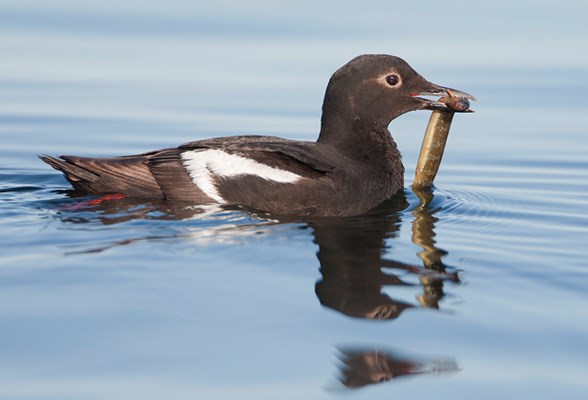SPRING migration this year has produced some very interesting bird sightings, including Say's phoebe at Maplewood Conservation Area in April.
This lovely flycatcher with its peach coloured breast is commonly seen in B.C.'s Interior, but is rare on the coast. It was seen in the sanctuary's salt marsh "hawking insects" - exactly what a flycatcher does best.
Double-crested and pelagic cormorants are not rare on the North Shore, and so the recent sightings of Brandt's cormorants at Lonsdale Quay were special. The birds were in fall breeding colours with their bright blue chin patch and white plumes - very handsome indeed! Both pelagic and Brandt's cormorants are strictly marine species. If you see a cormorant flying overland it is always a double-crested. Watch for cormorants perched on piers and pilings with their wings held outstretched in the so-called "wing-drying" pose.
Speaking of seabirds, there have been regular sightings at the Quay, Ambleside and other locations of the pigeon guillemot (gill-eh-mot).
Guillemots are members of the Alcid family, which includes murres, puffins, auks and the fabled marbled murrelet. Alcids are sometimes thought of as the penguins of the northern seas. By spring, guillemots are in
their beautiful black breeding plumage, sporting bright red legs and feet. They are strictly fishers, consuming such fare as sandlance. Watch for guillemots in Burrard Inlet from a good vantage like Maplewood's Osprey Point or the public pier at Ambleside, (an excellent spot to look for other sea-going species like Bonaparte's gull and terns).
Here is a bird sighting hot off the wire - a calliope hummingbird was observed at Maplewood Conservation Area. Two hummingbird species are commonly seen on the North Shore - Anna's and rufous, with calliope (cal-eye-o-pea) being the rarest. In the province's Interior, it is commonly seen along with the black-chinned hummingbird. A favourite nectar source for hummers like the calliope are the flowers of black twinberry, a member of the honeysuckle family. It's a nice shrub to plant in your garden to attract hummers. Later, its small yellow flowers are replaced by shiny blackberries.
Now that spring finally seems to be under way and waves of migrants are arriving to the North Shore, it's time to watch for warblers, vireos, tanagers, flycatchers and the blackheaded grosbeak. Yellow-rumped and Wilson's warblers are common, but also keep a watch for Townsend's, black-throated gray and MacGillivray's. In the past years, local rarities like Tennessee, Nashville and American redstart have been sighted. So keep watching, and listening.
American goldfinches and house finches are in their fine breeding colours and song. There have been several sightings of the lesser goldfinch in recent years, so watch for it.
Ospreys at Maplewood got busy carrying sticks to repair their nest as soon as they arrived back. Martins will be seen swooping around off Osprey Point, while warblers and other birds lending cheery notes to the woodland chorus, while in the background the voices of the lovely little tree frogs may be heard - and then a butterfly (maybe a Mourning Cloak) will go flitting by. It is the merry, tuneful and colourful month of May. Please join us on our monthly nature walk.
Al Grass is a naturalist with Wild Bird Trust of British Columbia, which sponsors free walks at Maplewood Flats Conservation Area on the second Saturday of every month. The next walk is Saturday, May 12. You can learn more about the returning of the spring birds of Maplewood. Meet at 10 a.m. at Maplewood Flats, 2645 Dollarton Hwy. (two kilometres east of the Iron Workers Second Narrows Memorial Crossing). Walks go rain or shine. www.wildbirdtrust.org.



